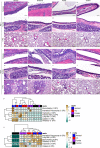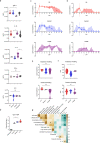This is a preprint.
SARS-CoV-2 disease severity and transmission efficiency is increased for airborne but not fomite exposure in Syrian hamsters
- PMID: 33398267
- PMCID: PMC7781302
- DOI: 10.1101/2020.12.28.424565
SARS-CoV-2 disease severity and transmission efficiency is increased for airborne but not fomite exposure in Syrian hamsters
Update in
-
SARS-CoV-2 disease severity and transmission efficiency is increased for airborne compared to fomite exposure in Syrian hamsters.Nat Commun. 2021 Aug 17;12(1):4985. doi: 10.1038/s41467-021-25156-8. Nat Commun. 2021. PMID: 34404778 Free PMC article.
Abstract
Transmission of SARS-CoV-2 is driven by contact, fomite, and airborne transmission. The relative contribution of different transmission routes remains subject to debate. Here, we show Syrian hamsters are susceptible to SARS-CoV-2 infection through intranasal, aerosol and fomite exposure. Different routes of exposure presented with distinct disease manifestations. Intranasal and aerosol inoculation caused more severe respiratory pathology, higher virus loads and increased weight loss. Fomite exposure led to milder disease manifestation characterized by an anti-inflammatory immune state and delayed shedding pattern. Whereas the overall magnitude of respiratory virus shedding was not linked to disease severity, the onset of shedding was. Early shedding was linked to an increase in disease severity. Airborne transmission was more efficient than fomite transmission and dependent on the direction of the airflow. Carefully characterized of SARS-CoV-2 transmission models will be crucial to assess potential changes in transmission and pathogenic potential in the light of the ongoing SARS-CoV-2 evolution.
Conflict of interest statement
Disclosure statement
The authors declare no competing financial interests.
Figures





References
-
- WHO, Coronavirus disease 2019 (COVID-19) Situation Report – 52. 2020.
Publication types
LinkOut - more resources
Full Text Sources
Miscellaneous
